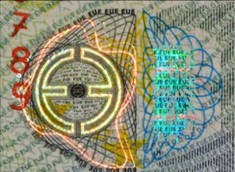



On 13 June 2023, the European Parliament and the Council of the European Union (EU) provisionally agreed on rules to digitise the Schengen visa procedure 1.

As well as digitising the visa application process, the new rules will also digitise the visa itself, probably ending the use of one of the longest running DOVIDs in travel document history and quite possibly marking the high-water mark for the use of diffractive, and other, security features on physical visa vignettes.
The Schengen area is the largest free travel zone in the world. It allows more than 400 million EU citizens, as well as visitors, to move freely around the bloc, and for goods and services to flow unhindered.
The COVID-19 pandemic had significant effects on the demand for Schengen visa applications worldwide, with 15 million issued in 2019 2, reducing to 2.4 million in 2021, and recovering to 5.9 million in 2022 – still nowhere near pre-pandemic levels.
The system is underpinned by a set of databases – the original Schengen Visa Information Systems, and two that are being put in place at the moment, ETIAS (the European Travel Information and Authorisation System) and the Entry/Exit system.
The rules agreed on 13 June will introduce two important changes: (1) digitisation of the Schengen visa application process, and (2) digitisation of the Schengen visa. The goal is to make the processing of such visas more efficient, cheaper and more user-friendly.
Under the current procedure, Schengen visa applicants must: submit a paper application, physically attend a consulate or external service provider at key stages of the application process and collect their visa. This can be burdensome on both travellers and consulates. Digitisation will streamline the procedure and will reduce overall administrative costs. It will also help to harmonise the visa application process for member states and third-country nationals.
With the new rules, in-person attendance at a consulate or external service provider should, in principle, only be mandatory for first-time applicants or applicants who have acquired a new travel document which needs to be verified, and for the collection of biometric identifiers.
The Schengen vignette (the visa sticker placed inside the passport) will be replaced by a digital Schengen visa, which will take the form of an encrypted 2D barcode. Digitisation will apply to both short-stay and long-stay visas and will also be issued by EU countries not yet fully applying the Schengen rules (Bulgaria, Romania and Cyprus).
An EU official, communicating directly with Holography News®, said: ‘when the new legislation will be fully applicable, visas issued by EU member states will be produced in a uniform digital format. The digital visa will be issued as a 2D barcode and will be printable. The technical standards for the format of the digital visa will be established in a forthcoming legal act.
The visa sticker will disappear completely, ie. there will be no sticker anymore on the passport. If printed, which is not mandatory, the visa will not be printed on a sticker.’
Concerns over the risk of the visa sticker being stolen with the passport, and the belief that digitisation is the solution, are not new.
As early as 2016, the European Commission published an 11-page document titled ‘Action plan to strengthen the European response to travel document fraud’. The report notes that electronic identification and trust services for electronic transactions can also help in the detection of false documents and enhance electronic document security by providing evidence of identity and preventing ID fraud through the mutual online validation of identity data.
It also called on the European Parliament and the Council to adopt proposals on a more secure uniform format for visas and residence permits for third country nationals.
As strong as the attraction for digital visas was in 2016, three years later the EU member states, the European Commission and the European Parliament voted once again in favour of Kinegrams for the new EU visa (see HN August 2019).
The security concept behind the visa sticker dates back to 1995, at a time when many countries were still using traditional stamps as proof of a visa and only a few countries, such as the Netherlands and Germany, were using the sticker version as proof of a visa.
As such, the EU Commission decided to develop a new document concept including a state-of-the-art security design to react to the counterfeit threat at the time, without significantly increasing the costs for the document itself.
The decision to have a physical document for the visa was taken regardless of the availability of Visa Information Systems because access to these systems could not be guaranteed at all times and in every control situation, for example, at land and sea borders as well as at airline check-in which have to switch to manual operation.
The new rules will need to be approved formally by the European Parliament and the Council of the European Union, which is likely to happen within a few months. Once the rules have been approved and implemented, there will likely be a transitional period of several years during which applications may be submitted either according to the current paper-based procedure or according to the new digital procedure.